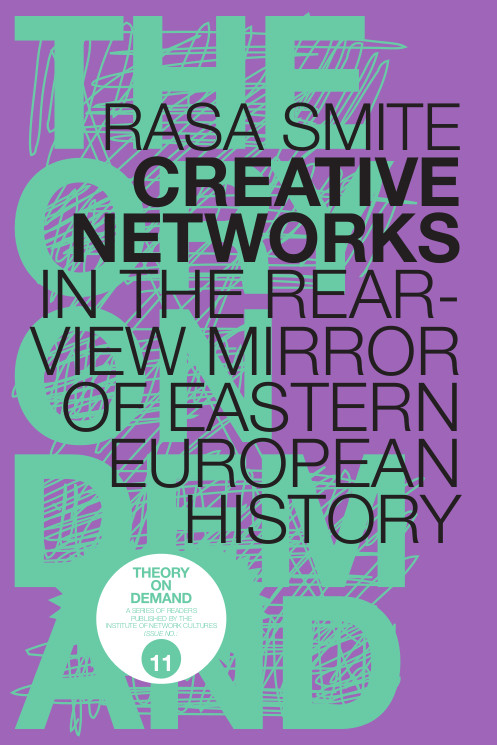Rasa Smite: Creative Networks: In the Rearview Mirror of Eastern European History (2011/2012)
Filed under book | Tags: · actor-network theory, cyberfeminism, eastern europe, internet, internet art, internet culture, latvia, media art, net art, network culture, networks, sound art, virtual communities

“Creative Networks explores the dawn of the Internet culture in the age of network society from the perspective of Eastern Europe. From a theoretical angle the networks are introduced and interpreted as complex socio-technical systems. The author analyzes the development of these networked self-organized formations starting off with ‘virtual communities’ of ‘creative networks’, which emerged during the early phase of the Internet, up to the phenomena of today’s online ‘social networks’. Along with the translocal case studies of Nettime, Syndicate, Faces and Xchange networks (as well as with the other important facets of the 1990s network culture in Europe), the author studies also local community networking case of alternative and digital culture that evolved around E-Lab in the 1990s in Latvia. By focusing primarily on the network culture of 1990s, this study reflects those changes in the social structure of today’s society that are occurring under the process of socio-technical transformation.
The book is based on a dissertation by Rasa Smite, with the title Creative Network Communities and was defended in Riga Stradins University, February 2011.”
First published in Latvian in Riga: RIXC and Liepaja: LiepU MPLab, 2011.
Translated by Linda Vebere
Publisher Institute of Network Cultures, Amsterdam 2012
Creative Commons Attribution Noncommercial No Derivative Works 3.0 Netherlands License
ISBN 9789081857505
160 pages
Review: Piibe Piirma (Baltic Screen Media Review, 2014).
PDF (updated on 2023-9-27)
Comment (0)Frohne, Schieren, Guiton (eds.): Present Continuous Past(s): Media Art. Strategies of Presentation, Mediation and Dissemination (2005)
Filed under book | Tags: · archive, archiving, art history, conservation, database, media art, preservation, storage, video art

“With a history of more than 30 years, media art plays an increasingly important role in the international discourse on contemporary art. The reception of canonical video works and electronic media installations is however restricted to temporary and locally defined displays in museum exhibitions or confined to incomplete catalogue documentations. This volume provides a unique combination of theoretical reflections on the reproducibility, preservation of authenticity and juridical implications of emulation techniques with practical approaches to archiving methods and commercial aspects of media art’s accessibility. It is an indispensible guide to the pro’s and con’s for new forms of de-centralized systems of mediation and the growing demands for liberal rules and easy access to online-presentations of media art. Uncomparable to other current publications, the book offers a practical manual with checklists for relevant websites and content profiles of major distribution companies.”
With contributions by Ursula Frohne, Ulrike Rosenbach, Sabine Flach, Elke Bippus and Dirck Möllmann, Mona Schieren, Lydia Haustein, Dieter Daniels, Katharina Ammann, Hans D. Christ and Stan Douglas, Dennis Del Favero / Neil Brown / Jeffrey Shaw / Peter Weibel, Jean-François Guiton, Rudolf Frieling, Monika Fleischmann / Wolfgang Strauss, Rens Frommé / Sandra Fauconnier, Lori Zippay, Bart Rutten.
Edited by Ursula Frohne, Mona Schieren, Jean-Francois Guiton
Publisher Springer, Vienna, 2005
Schriftenreihe der Hochschule für Künste Bremen series, 2
ISBN 3211254684, 9783211254684
223 pages
via Jo Morfin
PDF (updated on 2020-9-26)
Comments (4)Armin Medosch: Automation, Cybernation and the Art of New Tendencies, 1961-1973 (2012)
Filed under thesis | Tags: · 1960s, 1970s, art, art history, computer art, computing, cybernetics, informational capitalism, media art, politics, technology, yugoslavia
“My research investigates exhibitions as sites of research and appraises the possibilities and contradictions of a progressive and socially engaged media art practice. The international art movement New Tendencies (NT) (1961-1973) provides the material evidence through its exhibitions, symposia, artworks, catalogues, newsletters and artist’s statements. The basic methodological assumption behind my research is that new insights are gained by questioning the various interdependencies between NT and historical change.
NT was searching for a synthesis between socialist emancipation and artistic modernism by proposing to replace the notion of art with visual research. The project emerged in Zagreb, capital of Croatia which was then part of Yugoslavia, a Socialist nation which did not belong to the Eastern bloc and experimented with market Socialism combined with social self-management and self-government. Yugoslavia’s unique role between the hegemonic power blocs made it possible that an international, humanistic, and progressive art movement could emerge from its territory.
With every exhibition and conference NT articulated its artistic position and set itself into relation with the respective techno-economic paradigm. NT began during the height of Fordism, continued during Fordism’s moment of crisis in 1968, and ended when a new paradigm – informational capitalism – started to develop from within the old one. In this historical context, my hypothesis is that NT’s exploration of participatory art stands in direct relation to the rise of automation and cybernation in society. A further layer of inquiry is the historically changing relationship between manual and intellectual labour and how art addresses it.
By contextualising NT my research contributes a new dimension to the history of media art. Through the chosen methodology, a new understanding is gained not only of this important art movement but of the general dynamics of media art in the second half of the 20th century.” (Abstract)
Doctoral thesis
Arts and Computational Technology, Goldsmiths, University of London
369 pages
PDF, PDF (updated on 2015-7-12)
Comment (0)
